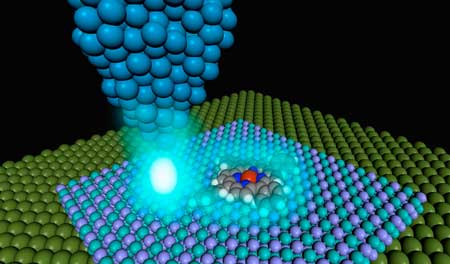| Posted: Oct 13, 2017 |
Spectroscopy gets to the point
(Nanowerk News) A technique so sensitive that it can detect the quantum transfer of energy between a single molecule and a silver nanostructure has been developed by RIKEN researchers (Physical Review Letters, "Single-molecule investigation of energy dynamics in a coupled plasmon-exciton system"). It enables the electronic properties of molecules to be probed at a much higher spatial resolution and sensitivity than conventional methods.
|
 |
| Creating a plasmon (white glow) by bringing the tip of a scanning tunneling microscope (blue spheres, top) close to a molecule (gray-and-white, cross-like structure) on a surface enables high-resolution spectroscopy. (Image: RIKEN Surface and Interface Science Laboratory)
|
|
Absorption spectroscopy is a vital tool for detecting and investigating molecules. An individual molecule absorbs light at frequencies determined by its quantum properties. An absorption spectrum of a molecule can thus be used as a fingerprint to identify the molecule’s presence in samples. It also reveals information about the structure of the molecule.
|
|
But since absorption spectroscopy generally uses an external light source to excite molecules, its spatial resolution is limited by the inability to focus light to a spot smaller than roughly half its wavelength, which is a few hundred nanometers for visible light.
|
|
Now, Hiroshi Imada and his colleagues from the RIKEN Surface and Interface Science Laboratory have developed a technique that overcomes this limitation by using plasmons, hybrid particles that are part light and part electron. Since plasmons can be as small as 1 nanometer, they make much finer probes than light beams.
|
|
“Our method surpasses conventional absorption spectroscopies using optical probes by two orders of magnitude in spatial resolution and about five orders in sensitivity,” says Imada.
|
|
Imada and the team created a plasmon by passing an electric current through the sharp silver tip of their scanning tunneling microscope in the vicinity of a silver surface covered with sodium chloride (Fig. 1). The plasmon then excited a nearby molecule, and the coupled plasmon–molecule system emitted light across a broad range of wavelengths. This emission spectrum depended sensitively on the electronic properties of the molecule. Furthermore, it could be tuned by altering the distance between the plasmon and the molecule.
|
|
The scientists analyzed the emitted light and identified a dip at one particular wavelength. The quantum-based theory they developed indicated that these dips were caused by energy transfer between the localized plasmon and the molecule: energy flowing in one direction quantum mechanically interferes with energy flowing the other way. “This indicates that our method can even reveal the quantum mechanical nature of molecules, which is imperceptible with conventional methods,” notes Imada.
|
|
The team has ambitious plans for the future. “We hope to develop this technique to realize time-resolved, single-molecule absorption spectroscopy, which has never been achieved before,” says Imada.
|

